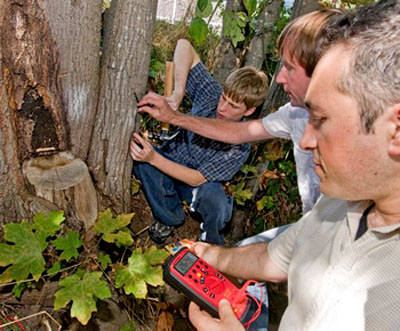|
September 10, 2009
from
MotherNatureNetwork Website
Researchers have discovered that there's enough power in living trees
to run an electric circuit.
Engineers Babak Parviz and Brian Otis demonstrate with students how a device can be plugged into a tree for power. (Photo: University of Washington)
But now
researchers at the University of Washington have discovered nature's
alternative to the power outlet: living trees.
UW engineers Babak Parviz and Brian Otis have invented an electrical device that can be plugged directly into any tree for power.
The research was based upon a breakthrough study last year out of MIT, when scientists found that plants generate a voltage of up to 200 millivolts when one electrode is placed in a plant and the other in the surrounding soil.
Those researchers are already designing
devices which act as forest sensors powered entirely by this new
method. But until now, no one has applied these findings to the
development of tree power.
He spent his summer wandering around
the woods surrounding campus, hooking nails to
big-leaf maple trees
and connecting them to his voltmeter. Sure enough, the trees
registered a steady voltage of up to a few hundred millivolts.
Because the voltage generated by the trees can
be so small, the resulting device - a boost converter - was
specialized to take input voltages of as little as 20 millivolts to
be stored to produce greater output. The device's produced output
voltage ended up being 1.1 volts, which is enough to run low-power
sensors.
At the very least, these findings open the door for new generations of electronics which might eventually be efficient enough to take advantage of tree power.
It certainly excites the imagination. Maybe in time we'll be witness to weekend picnickers lounging in local parks with their iPods and cell phones plugged into the surrounding foliage.
|

